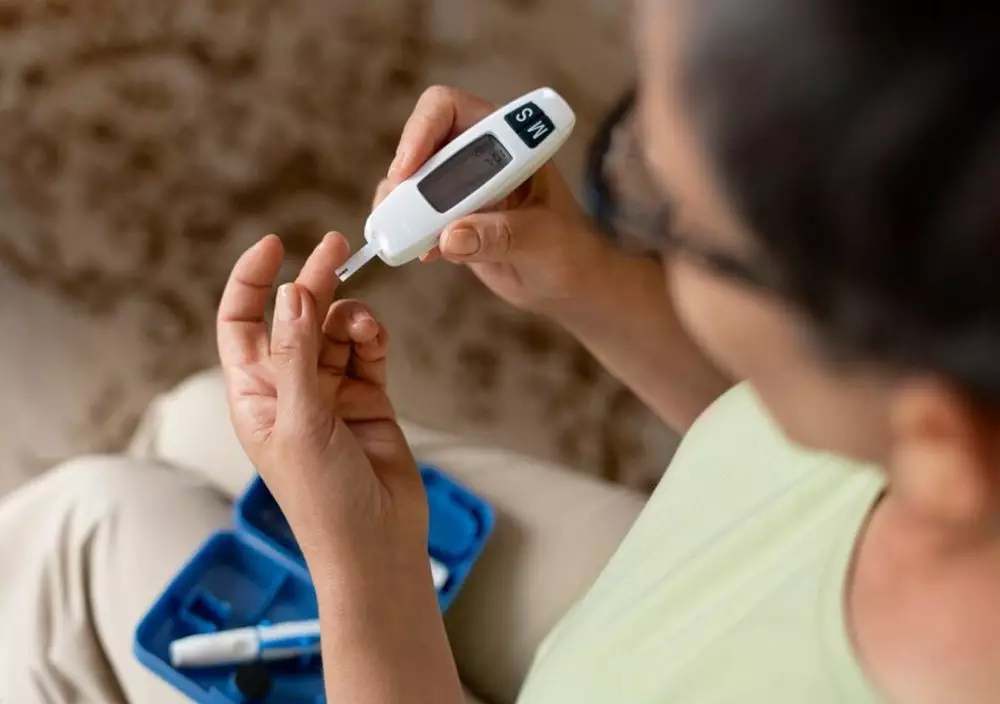foto: freepik.com
Brilio.net - Hypoglycemia in children is a condition where the blood sugar (glucose) level in the child's body becomes very low, causing clinical symptoms such as dizziness, paleness, sweating, and even syncope. This condition can occur in babies, children, teenagers, and can also occur in neonates (newborn babies less than 48 hours old).
Hypoglycemia in babies and children can occur due to various causes, such as lack of nutritional intake during pregnancy, infection, birth asphyxia, liver disease, congenital metabolic disease, too much insulin due to uncontrolled diabetes in pregnant women, or too much insulin due to medication use. certain.
Quoting from the journal The association gene polymorphism and type 1 diabetes mellitus, accessed from the unair.ac.id page, it is explained that a person can be said to have hypoglycemia if the blood sugar level is less than 2.6 mmol/L (< 47 mg/dl), whereas For children, blood glucose levels below 60 mg/dl have the potential to cause hypoglycemia. However, for children, especially those suffering from diabetes, it is recommended to maintain blood sugar levels above 70 mg/dl.
This condition can have negative impacts on the body, such as seizures, decreased consciousness, and even brain damage. To understand more about the dangers of hypoglycemia in children, let's get to know the symptoms, treatment steps and nutritional strategies for preventing it. Reported by birlio.net from various sources on Tuesday (28/5).
What is hypoglycemia and its symptoms?

Recognize the symptoms of hypoglycemia, treatment steps, and nutritional strategies to prevent it
freepik.com
Low blood sugar or in the medical world is known as hypoglycemia, a condition when blood sugar (glucose) levels in a child's body fall below normal limits. In neonates less than 48 hours old, symptoms of hypoglycemia can include lethargy, tachypnea, hemodynamic instability, apnea, seizures, or even cardiac arrest.
Milder symptoms include cyanosis, hypothermia, or diaphoresis. Blood sugar levels are generally less than 50 mg/dL. In neonates aged more than 48 hours, babies and young children who cannot yet communicate their symptoms, hypoglycemia can be diagnosed if the blood sugar level is below 60 mg/dL. However, if you look closely, the symptoms of hypoglycemia in children can vary, some of the commonly found symptoms are:
1. Dizziness, children may experience dizziness or loss of balance.
2. Heart palpitations
3. Excessive sweating, which can be a sign that the body is experiencing a lack of sugar.
4. Headache
5. Pale
6. Abnormal changes in mood and behavior, such as becoming irritable or having difficulty concentrating.
7. Seizures, hypoglycemia can cause seizures in children, which can put them at risk of brain damage.
8. Decreased consciousness
These symptoms can appear suddenly and vary in each sufferer. Therefore, it is important to recognize the symptoms of hypoglycemia well and immediately contact a doctor if these symptoms are found in a child
Causes of hypoglycemia in children.

Recognize the symptoms of hypoglycemia, treatment steps, and nutritional strategies to prevent it
freepik.com
There are several causes of hypoglycemia in children, including:
1. Type 1 diabetes
Type 1 diabetes is an autoimmune condition in which a child's body attacks the cells in the pancreas that produce insulin. Insulin is a hormone that helps move glucose from the blood into cells to be used as energy.
Children with type 1 diabetes need insulin injections to control their blood sugar levels. Hypoglycemia is a common complication in children with type 1 diabetes, especially if they use insulin or other diabetes medications.
2. Neonatal hypoglycemia
Neonatal hypoglycemia is hypoglycemia that occurs in newborn babies. This can be caused by various factors, such as:
- Premature birth
- Low birth weight
- Infection
- Diabetes in the mother
- Metabolic disorders
3. Congenital hyperinsulinism hypoglycemia
Congenital hyperinsulinism hypoglycemia is a genetic disorder that causes the pancreas to produce too much insulin. This can cause severe hypoglycemia in newborns and children.
4. Other metabolic disorders
There are several other metabolic disorders that can cause hypoglycemia in children, such as:
- Liver disease
- Kidney illness
- Deficiency of certain hormones
5. Certain medications
Some medicines, such as diabetes medicines and weight loss medicines, can cause hypoglycemia in children.
6. Excessive fasting and heavy exercise.
Fasting and exercise are good for the body's metabolism. However, if done excessively it can trigger low blood sugar levels. Especially for children with a history of diabetes, they can potentially experience hypoglycemia.

Recognize the symptoms of hypoglycemia, treatment steps, and nutritional strategies to prevent it
freepik.com
Handling hypoglycemia in children includes several steps that must be taken to return blood sugar levels to normal limits. Please remember, the best treatment when a child experiences hypoglycemia is to see a doctor immediately. So, there are several common handling methods:
1. Giving glucose
Giving glucose, either orally or intravenously, is the main way to treat hypoglycemia in children. It is recommended to give glucose orally if the child can still tolerate oral administration. If not, then glucose needs to be given intravenously.
2. Providing fast-acting carbohydrates
If the child is still conscious and cooperative, fast-acting carbohydrates can be given as much as 15 g or 0.2 g/kg for babies. It can be given in the form of juice, a tube of glucose gel, or four glucose tablets. Intravenous access can be simultaneously prepared if it is considered that the child will fail to respond to oral intervention.
3. Giving sublingual sugar
If oral glucose is not available or in cases where it is difficult to provide intravenous access, administering sublingual sugar can be an alternative therapy while the child is still conscious. This sublingual sugar can be sugar mixed with water, then given under the child's tongue.
4. Giving glucose fluid infusion
If a patient with hypoglycemia is treated in a hospital, the doctor will generally give an infusion of glucose so that the sugar level returns to normal.
5. Giving medication to increase the body's sugar levels
If the hypoglycemia is very severe, part of the pancreas can be removed. This treatment will continue to be monitored until the baby has stable, normal glucose levels.
Food intake prevents hypoglycemia in children.

Recognize the symptoms of hypoglycemia, treatment steps, and nutritional strategies to prevent it
freepik.com
Hypoglycemia has quite a dangerous impact on health, therefore it is important to maintain blood sugar levels within normal limits in order to prevent hypoglycemia. One of the best ways to do this is to regulate your child's diet.
Quoting from Healthline and a journal from the National Library of Medicine entitled Dietary intake and risk of non-severe hypoglycemia in adolescents with type 1 diabetes, there are several tips for good food intake to prevent hypoglycemia, including:
1. Consume complex carbohydrates.
Complex carbohydrates are digested more slowly than simple carbohydrates, so they help keep blood sugar levels stable for longer. Examples of complex carbohydrates that are good for children include:
- Natural grains such as whole wheat bread, whole wheat cereal, or brown rice
- Vegetables, for example broccoli, carrots, sweet potatoes, peas and spinach.
- Fruits such as apples, bananas, pears, oranges, berries
- Nuts, for example almonds, peanuts, lentils and red beans.
2. Proteins.
To prevent hypoglycemia, you need to eat foods that are high in protein. Protein helps slow the absorption of carbohydrates into the bloodstream, thereby helping keep blood sugar levels stable. Examples of protein that are good for children include: Lean meat such as skinless chicken, fish, lean beef and eggs. Meanwhile, beverage products rich in protein include low-fat milk, low-fat yogurt, low-fat cheese
3. Consume foods high in fiber.
Fiber helps slow digestion and absorption of carbohydrates into the bloodstream. This helps maintain stable blood sugar levels, preventing spikes and drops in blood sugar that can cause hypoglycemia.
In addition, fiber helps increase feelings of fullness and reduces the desire to overeat. Therefore, it influences hypoglycemia sufferers to maintain ideal body weight and reduces the risk of diabetes complications. Examples of foods that are high in fiber are beans, potatoes, carrots, onions, bananas, mangoes, apples, oranges, green beans, black beans, red beans and grapes.
4. Drink water regularly.
Drinking enough water helps keep a child's body well hydrated and helps prevent hypoglycemia. Children should drink 8 glasses of water per day. A study published in the journal Journal of the American Dietetic Association found that children with diabetes who drank enough water had a lower risk of hypoglycemia than children who did not drink enough water.
(brl/ola)